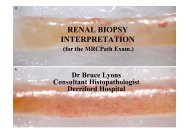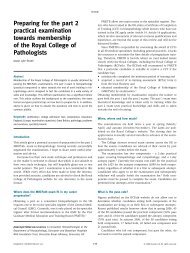Differentiating hyperplasias and in situ carcinomas of ... - Pathkids.com
Differentiating hyperplasias and in situ carcinomas of ... - Pathkids.com
Differentiating hyperplasias and in situ carcinomas of ... - Pathkids.com
You also want an ePaper? Increase the reach of your titles
YUMPU automatically turns print PDFs into web optimized ePapers that Google loves.
Intralum<strong>in</strong>al Proliferative Lesions<br />
<strong>of</strong> Term<strong>in</strong>al Duct Lobular Units<br />
Clive S Holgate<br />
Derriford Hospital, Plymouth<br />
May 2006
Intralum<strong>in</strong>al Proliferative Lesions <strong>of</strong><br />
Term<strong>in</strong>al Duct Lobular Units<br />
Four dist<strong>in</strong>ct but related entities –<br />
Columnar cell lesions<br />
Ductal hyperplasia<br />
Ductal carc<strong>in</strong>oma-<strong>in</strong>-<strong>situ</strong><br />
Lobular neoplasia
• Blunt duct adenosis<br />
Columnar cell lesions<br />
• Atypical cystic lobules<br />
• Cancerization <strong>of</strong> small ectatic ducts <strong>of</strong> the breast by<br />
ductal carc<strong>in</strong>oma <strong>in</strong> <strong>situ</strong> cells with apocr<strong>in</strong>e snouts<br />
• Hypersecretory hyperplasia<br />
• Columnar alteration with prom<strong>in</strong>ent apical snouts<br />
<strong>and</strong> secretions (CAPPS)<br />
• Mammary ductal <strong>in</strong>traepithelial neoplasia-flat type<br />
• “Cl<strong>in</strong>g<strong>in</strong>g ductal carc<strong>in</strong>oma <strong>in</strong> <strong>situ</strong>"<br />
• Hyperplastic Unfolded Lobules (HULs)<br />
• Enlarged lobular units with columnar alteration<br />
(ELUCA)<br />
• Columnar cell change / columnar cell hyperplasia
Arise from structurally normal TDLUs
Columnar Cell Change<br />
• Columnar epithelial cells (1 or 2 cell depth) l<strong>in</strong>e<br />
TDLU, <strong>of</strong>ten mildly dilated<br />
• Uniform, ovoid nuclei<br />
• Perpendicular to basement membrane<br />
• Cytologically bl<strong>and</strong><br />
• Mitotic figures rare<br />
• Apical snouts <strong>of</strong>ten present<br />
• Secretions may be present <strong>in</strong> lumen with Ca 2+
Columnar Cell Change with Cytological<br />
Atypia / Flat Epithelial Atypia<br />
• TDLUs darker than normal at low power<br />
• One or more layers <strong>of</strong> monotonous, cuboidal<br />
to columnar cells, resembl<strong>in</strong>g low grade DCIS<br />
• Rounder nuclei with mild <strong>in</strong>crease <strong>in</strong><br />
nuclear/cytoplasmic ratio<br />
• Dispersed or marg<strong>in</strong>ated chromat<strong>in</strong><br />
• Nucleoli sometimes more prom<strong>in</strong>ent<br />
• Mitotic figures rare<br />
• MAY BE SUBTLE !<br />
N.B. High grade atypia = flat high grade DCIS<br />
NOT columnar cell change with atypia
Reproducibility <strong>of</strong> Diagnosis <strong>of</strong> Flat Atypia<br />
• 28 cases Powerpo<strong>in</strong>t tutorial from Stu Schnitt<br />
• 8 pathologists sent images <strong>of</strong> 30 cases<br />
• Complete agreement re presence or absence<br />
<strong>of</strong> FEA <strong>in</strong> 24 <strong>of</strong> the 30 cases (80.0%)<br />
• 7 or more agreed <strong>in</strong> 26 cases (86.7%)<br />
• 6 or more agreed <strong>in</strong> 28 cases (93.3%)<br />
Kappa = 0.83<br />
O!Malley et al. Mod Pathol. 2006;19:172-9.
Columnar Cell Hyperplasia<br />
• Similar to CCC, but stratification > 2 cells depth<br />
• Nuclear morphology as <strong>in</strong> CCC<br />
• May be more crowd<strong>in</strong>g & overlapp<strong>in</strong>g <strong>of</strong> nuclei<br />
• Tufts or hummocks mimick<strong>in</strong>g micropapillae<br />
• Exaggerated apical snouts - hobnail appearance<br />
• Intralum<strong>in</strong>al secretions <strong>of</strong>ten with Ca 2+<br />
N.B. If true micropapillae, bridges, cribriform<br />
pattern etc = consider as ADH/DCIS
Assessment <strong>of</strong> Columnar Cell Lesions<br />
Cytological atypia<br />
No<br />
Cytological atypia<br />
Yes<br />
Hyperplasia<br />
No<br />
Columnar cell<br />
change<br />
Columnar cell<br />
atypia<br />
(Flat epithelial<br />
atypia) *<br />
* If high grade = DCIS<br />
Columnar cell<br />
hyperplasia<br />
Columnar cell<br />
hyperplasia<br />
with<br />
cytological<br />
atypia*<br />
Hyperplasia<br />
Yes<br />
Simple Complex<br />
ADH or DCIS<br />
ADH or DCIS
Columnar Cell Lesions<br />
• Often a spectrum - columnar cell change to columnar<br />
cell hyperplasia to columnar cell hyperplasia with<br />
atypia to low grade DCIS
Sample<br />
thoroughly
Columnar Cell Lesions<br />
Immunohistochemistry Unhelpful<br />
• Most cells <strong>in</strong> columnar cell lesions show<br />
lum<strong>in</strong>al cytokerat<strong>in</strong> (e.g. CK19) positivity<br />
• No expression with cytokerat<strong>in</strong>s 5 <strong>and</strong> 6<br />
• Strong homogeneous nuclear estrogen<br />
receptor & progesterone receptor positivity
Columnar cell lesions <strong>of</strong> the breast: the<br />
miss<strong>in</strong>g l<strong>in</strong>k <strong>in</strong> breast cancer progression?<br />
• CCL <strong>in</strong> context <strong>of</strong> UEH & DCIS & <strong>in</strong>vasive carc<strong>in</strong>oma<br />
• 81 lesions from 18 patients<br />
• Morphological review, IHC & CGH<br />
• CCLs were ER & PgR positive, CK5/6 & CK14<br />
negative with low numbers <strong>of</strong> genetic alterations with<br />
recurrent 16q loss, i.e. similar to low grade DCIS &<br />
<strong>in</strong>vasive carc<strong>in</strong>oma<br />
• Overlapp<strong>in</strong>g chromosomal alterations between CCL<br />
<strong>and</strong> more advanced lesions with<strong>in</strong> <strong>in</strong>dividual TDLUs<br />
suggest <strong>com</strong>monality <strong>in</strong> molecular evolution<br />
Simpson et al. Am J Surg Pathol. 2005;29:734-46!
Core Biopsy<br />
Columnar cell change or<br />
Columnar cell hyperplasia<br />
Practicalities<br />
Columnar change or hyperplasia<br />
with atypia / flat epithelial atypia<br />
Excision<br />
Columnar cell change or<br />
Columnar cell hyperplasia<br />
Columnar change or hyperplasia<br />
with atypia / flat epithelial atypia<br />
No additional levels<br />
Excision not required<br />
Diagnostic excision<br />
re<strong>com</strong>mended<br />
No levels<br />
No treatment required<br />
Levels<br />
Submit more/all tissue
History <strong>of</strong> LCIS<br />
• Described by Foote & Stewart <strong>in</strong> 1941<br />
• Detection <strong>in</strong>creased <strong>in</strong> recent years, found <strong>in</strong><br />
approximately 1% (0.5 - 3.6%) <strong>of</strong> all breast<br />
biopsy specimens but true <strong>in</strong>cidence is<br />
unclear<br />
• May be widespread, with high rates <strong>of</strong><br />
multicentricity (60-80%) & bilaterality (23-<br />
35%)
Cancer Risk <strong>in</strong> Lobular Neoplasia<br />
• Follow-up <strong>of</strong> 39 <strong>of</strong> 48 patients (from 10,542 benign<br />
breast biopsies (0.5%))<br />
• Higher risk <strong>of</strong> cancer with LCIS, 9x, & lower risk with<br />
more subtle examples - ALH, 4-5x<br />
Page DL. Human Pathology. 1991; 22; 1232-1239<br />
• Meta-analysis <strong>of</strong> 9 studies <strong>of</strong> 228 patients<br />
• 15% developed ipsilateral <strong>in</strong>vasive cancer<br />
• 9% developed contralateral carc<strong>in</strong>oma<br />
• Ipsilateral cancer 3 x more likely than contralateral<br />
Page DL. Lancet. 2003;361:125-9
LCIS Vs ALH<br />
LCIS<br />
• More than half ac<strong>in</strong>i filled & distended by<br />
characteristic cells with no central lumen<br />
• Practically, 8 or more cells with<strong>in</strong> crosssection<br />
<strong>of</strong> ac<strong>in</strong>us<br />
ALH<br />
• Partly fill ac<strong>in</strong>us with m<strong>in</strong>imal or no distension<br />
<strong>and</strong> lum<strong>in</strong>a may still rema<strong>in</strong><br />
• Number <strong>of</strong> ac<strong>in</strong>i <strong>in</strong>volved < half<br />
• May have admixed myoepithelial cells
LCIS
ALH
LCIS Vs. Low Grade Solid DCIS<br />
• Both processes - fill<strong>in</strong>g <strong>of</strong> membrane-bound spaces<br />
by uniform, regularly-placed cells with clear cytoplasm<br />
• DCIS more sharply def<strong>in</strong>ed cell membranes<br />
• LCIS more discohesion<br />
• Intracytoplasmic lum<strong>in</strong>a more <strong>of</strong>ten <strong>in</strong> LCIS<br />
• Low power view shows lobulo-centricity <strong>of</strong> LCIS, more<br />
haphazard lobular & duct distortion <strong>in</strong> DCIS – not<br />
always available <strong>in</strong> core biopsy<br />
• If features <strong>of</strong> both present then classify as LCIS &<br />
DCIS because <strong>of</strong> bilateral & precursor risk
Dist<strong>in</strong>guish<strong>in</strong>g LCIS from DCIS
Dist<strong>in</strong>guish<strong>in</strong>g LCIS from DCIS<br />
Any additional features/tests?
E-cadher<strong>in</strong>
E-Cadher<strong>in</strong><br />
• 28 cases <strong>of</strong> <strong>in</strong>determ<strong>in</strong>ate CIS:<br />
• Group 1 (6) - all cytological & architectural<br />
features <strong>of</strong> LCIS but with <strong>com</strong>edo necrosis<br />
• Group 2 (17) - small, uniform cells, either<br />
grow<strong>in</strong>g <strong>in</strong> solid pattern with focal microac<strong>in</strong>arlike<br />
structures but with discohesion, or grow<strong>in</strong>g<br />
<strong>in</strong> a cohesive pattern but with <strong>in</strong>tracytoplasmic<br />
vacuoles<br />
• Group 3 (5) - marked pleomorphism & nuclear<br />
atypia but discohesive growth<br />
• All group 1 & group 3 cases E-cadher<strong>in</strong> negative<br />
• Group 2 heterogeneous E-cadher<strong>in</strong> sta<strong>in</strong><strong>in</strong>g<br />
Jacobs TW. Am J Surg Pathol 2001;25:229-36
Pleomorphic LCIS<br />
• Lack E-cadher<strong>in</strong> & beta-caten<strong>in</strong><br />
• Ga<strong>in</strong> <strong>of</strong> 1q & loss <strong>of</strong> 16q = typical <strong>of</strong> lobular ca.<br />
• Amplification <strong>of</strong> c-myc <strong>and</strong> HER2<br />
• Same precursor or same genetic pathway as<br />
classic lobular carc<strong>in</strong>omas<br />
Reis-Filho J et al. J Pathol. 2005;207:1-13<br />
• Lobular IHC pr<strong>of</strong>ile & genetics<br />
• More “aggressive” re proliferation, HER2 etc<br />
• Very limited data on cl<strong>in</strong>ical behaviour
Histological Features – Ductal Hyperplasia <strong>and</strong> DCIS.<br />
FEATURE UEH ADH LG DCIS<br />
Size Variable 3mm<br />
Cellular Mixed Uniform S<strong>in</strong>gle cell<br />
Composition <strong>and</strong> mixed population<br />
Architectural Variable Micropap, Micropap,<br />
cribriform, cribriform<br />
solid solid<br />
Lum<strong>in</strong>al Irregular, Dist<strong>in</strong>ct/ Punched out<br />
slit-like irregular
Histological Features – Ductal Hyperplasia <strong>and</strong> DCIS.<br />
FEATURE UEH ADH LG DCIS<br />
Cell Stream<strong>in</strong>g, Nuclei at Micropap.<br />
Orientation taper<strong>in</strong>g right angles structures – no<br />
bridges to bridges, cores or smooth<br />
rigid structures well-del<strong>in</strong>eated<br />
geometric<br />
spaces. Cell<br />
bridges rigid<br />
cribriform DCIS<br />
Nuclear Uneven Even/uneven Even<br />
spac<strong>in</strong>g
Histological Features – Ductal Hyperplasia <strong>and</strong> DCIS.<br />
FEATURE UEH ADH LG DCIS<br />
Cell Small ovoid, Small uniform Small<br />
Character shape variation or medium- uniform<br />
sized monotonous<br />
monotonous cells<br />
nuclei (focally)<br />
Nucleoli Indist<strong>in</strong>ct S<strong>in</strong>gle small S<strong>in</strong>gle small<br />
Mitoses Infrequent Infrequent Infrequent<br />
Necrosis Rare Rare If present,<br />
small<br />
particulate<br />
debris <strong>in</strong><br />
spaces
Intraductal Epithelial Proliferations
Atypical Ductal Hyperplasia<br />
Architectural features<br />
• Some features <strong>of</strong> UEH & some features <strong>of</strong><br />
low grade DCIS<br />
Cytological features<br />
• Cells similar to those seen <strong>in</strong> low grade DCIS<br />
present <strong>in</strong> a portion <strong>of</strong> the space<br />
• Second population <strong>of</strong> cells typical <strong>of</strong> florid<br />
hyperplasia also present<br />
Size/extent<br />
• Less than 2 duct spaces with <strong>com</strong>plete<br />
<strong>in</strong>volvement (2mm)
NHS BSP EQA Scheme<br />
Kappa!s for overall diagnosis (all participants)<br />
Benign Atypical In <strong>situ</strong> / Invasive Overall<br />
hyperplasia Micro-<strong>in</strong>vasive<br />
902, 911, 912 0.72 0.19 0.71 0.81 0.68<br />
921, 922, 931 0.75 0.16 0.71 0.86 0.72<br />
932, 941, 942 0.81 0.15 0.75 0.88 0.77<br />
951, 952, 961 0.75 0.17 0.77 0.86 0.77<br />
962, 971, 972 0.79 0.26 0.81 0.91 0.82<br />
981, 982, 991 0.84 0.13 0.69 0.90 0.79<br />
All 0.79 0.18 0.75 0.88 0.77
Study Case 6<br />
Panel Results:<br />
Your Score<br />
H 1 1<br />
ADH 4 3<br />
DCIS 1 1
Inter-observer Variability <strong>in</strong><br />
Diagnosis <strong>of</strong> ADH<br />
• Is real problem for very small % <strong>of</strong> cases<br />
• Beth Israel Deaconess Medical Center, < 2%<br />
<strong>of</strong> breast biopsies <strong>in</strong> borderl<strong>in</strong>e category
Common adult stem cells <strong>in</strong> the breast -<br />
biological concept<br />
Ck5+<br />
Ck5/Ck8/18/19+<br />
Ck5/SMA+<br />
Ck8/18/19+<br />
SMA+<br />
“cells differentiate toward gl<strong>and</strong>ular or myoepithelial cells,<br />
pass<strong>in</strong>g through either Ck5/Ck8/18/19 or Ck5/SMA-positive<br />
<strong>in</strong>termediates” Bocker et al. Lab Invest 2002;82; 737-745
Cytokerat<strong>in</strong>s <strong>in</strong> Intraductal Hyperplasia<br />
Lum<strong>in</strong>al epithelial cytokerat<strong>in</strong>s (CK 8, 18, 19) & basal<br />
<strong>in</strong>termediate epithelial cytokerat<strong>in</strong>s (CK 5, 6, 14) may<br />
be helpful <strong>in</strong> difficult <strong>in</strong>traductal proliferations -<br />
identify a mixed cell population <strong>in</strong> UEH<br />
Bocker W. Pathologe 1997;18:3-18
Diagnosis <strong>of</strong> (low<br />
grade) DCIS/ADH<br />
with CK 5/6
Gynae<strong>com</strong>astoid Hyperplasia<br />
• Small, papillary-like clusters <strong>of</strong> epithelial cells<br />
• No fibrovascular stalks<br />
• 2 - 3 cells above basement membrane<br />
• Papillary clusters taper towards lumen<br />
• Small, pyknotic nuclei arranged around outer<br />
edge <strong>of</strong> papillary structures<br />
• Variable nuclear features - not regular, evenly<br />
spaced, c.f. DCIS<br />
Tham KT et al. Prog <strong>in</strong> Surg Pathol. 1989; 10; 101-9
Gynae<strong>com</strong>astoid Hyperplasia
Gynae<strong>com</strong>astoid Hyperplasia
ER <strong>in</strong> Diagnosis <strong>of</strong> Intraductal Epithelial<br />
Proliferations<br />
• % <strong>of</strong> ER +ve cells slightly <strong>in</strong>creased <strong>in</strong> UEH<br />
• ER +ve surrounded by ER -ve cells or<br />
contiguous groups <strong>of</strong> +ve cells (sometimes<br />
>90% cells)<br />
• In ADH, LCIS & low grade DCIS contiguous +ve<br />
cells<br />
Shoker BS et al. J Pathol 1999;188;237-244
Diagnosis <strong>of</strong> DCIS - NHS BSP EQA Scheme<br />
Kappa - Overall Diagnosis<br />
Circulation Benign In <strong>situ</strong> / MI Inv. Overall<br />
902,911,912 0.72 0.71 0.81 0.68<br />
921,922,931 0.75 0.71 0.86 0.72<br />
932,941,942 0.81 0.75 0.88 0.77<br />
951,952,961 0.75 0.77 0.86 0.77<br />
962,971,972 0.79 0.81 0.91 0.82<br />
981,982,991 0.84 0.69 0.90 0.79<br />
All 0.79 0.75 0.88 0.77<br />
0.00 – 0.20 Slight<br />
0.21 – 0.40 Fair<br />
0.41 – 0.60 Moderate<br />
0.61 – 0.80 Substantial<br />
0.81 – 1.00 Almost perfect
Classification <strong>of</strong> DCIS<br />
Extent <strong>of</strong> DCIS - Relation to Architecture<br />
S<strong>in</strong>gle<br />
quadrant<br />
Multiple<br />
qu<strong>and</strong>rant<br />
Total<br />
Comedo Solid Cribriform Micropapillary Total<br />
24<br />
2<br />
(8%)<br />
26<br />
19<br />
4<br />
(17%)<br />
23<br />
20<br />
5<br />
(20%)<br />
25<br />
4<br />
10<br />
(71%)<br />
14<br />
67<br />
21<br />
88<br />
Bellamy. Hum Pathol 1993; 24;16
• High grade<br />
DCIS - NHS BSP Grade<br />
• Intermediate grade<br />
• Low grade<br />
Nuclear size, pleomorphism, nucleoli, mitoses<br />
(Growth pattern, necrosis & polarisation)<br />
Pathology Report<strong>in</strong>g <strong>of</strong> Breast Disease.<br />
NHS BSP Publication 58, 2005
Evidence for Progression <strong>of</strong> DCIS<br />
Type Treatment Out<strong>com</strong>e<br />
High grade Biopsy alone Progression 50% <strong>in</strong> 5 yrs<br />
Low grade Biopsy alone Progression 30% <strong>in</strong> 15 yrs<br />
Low grade DCIS<br />
40% <strong>of</strong> 28 patients with "missed! lesions on biopsy<br />
developed <strong>in</strong>vasion at same site at 30 year follow-up<br />
Page et al, Cancer 1995; 76; 1196-1200
DCIS Genetic studies<br />
• Allelic imbalance analysis suggests that low<br />
grade & high grade carc<strong>in</strong>omas follow different<br />
genetic pathways<br />
Roylance et al, J Pathol 2002; 196:32-36
Excision <strong>of</strong> DCIS<br />
3D Mapp<strong>in</strong>g Egans Technique<br />
82 cases<br />
1 quadrant 66%<br />
>1 quadrant 23%<br />
Central 11%<br />
81 cases 1 duct system<br />
1 case Multiple ducts systems<br />
= a unicentric process<br />
Holl<strong>and</strong>. Lancet 1990; 335; 519
BMJ 2005; 331; 789-90
Medial<br />
Serial slic<strong>in</strong>g<br />
Superior<br />
Max<br />
dimension<br />
Inferior<br />
Specimen H<strong>and</strong>l<strong>in</strong>g<br />
Lateral<br />
Slice from mid specimen<br />
Anterior/Superficial<br />
Superior<br />
Distance to nearest marg<strong>in</strong><br />
Inferior<br />
Posterior/Deep
Excision <strong>of</strong> DCIS<br />
Prediction <strong>of</strong> Disease Extent by Radiology<br />
Comedo / Solid 85% <strong>of</strong> area visible<br />
mammographically<br />
Micropapillary / Cribriform 50% <strong>of</strong> area visible<br />
mammographically
Excision <strong>of</strong> DCIS - Marg<strong>in</strong>s<br />
• Serial subgross technique<br />
• 181 patients with WLE for DCIS<br />
• Involved = “with<strong>in</strong> 1mm <strong>of</strong> any <strong>in</strong>ked or dyed marg<strong>in</strong>”<br />
• Residual disease <strong>in</strong> 43% with apparently clear marg<strong>in</strong>s<br />
Silverste<strong>in</strong> et al. Cancer 1994;73;2985-89<br />
• 232 patients with lumpectomy for DCIS<br />
• Residual disease <strong>in</strong> 10 <strong>of</strong> 73 (14%) with >1mm clearance<br />
Cheng et al. J Nat Cancer Inst 1997;89;1356-60
Intralum<strong>in</strong>al Proliferative Lesions <strong>of</strong><br />
Term<strong>in</strong>al Duct Lobular Units.<br />
Management.<br />
Diagnosis Core biopsy Re<strong>com</strong>mendation<br />
Columnar cell change B2 No further action<br />
Columnar cell hyperplasia B2 No further action<br />
Columnar cell change/ B3 Open diagnostic bx<br />
hyperplasia with atypia<br />
ALH B3 ? Open diagnostic bx<br />
LCIS B3 ? Open diagnostic bx<br />
LCIS (pleomorphic) B3 or B5a ? Complete excision<br />
Ductal hyperplasia B2 No further action<br />
Ductal hyperplasia with B3 Open diagnostic bx<br />
Atypia<br />
DCIS B5a Complete excision
Thanks to –<br />
Dr. Sarah P<strong>in</strong>der,<br />
Addenbrooke’s Hospital,<br />
Cambridge.








